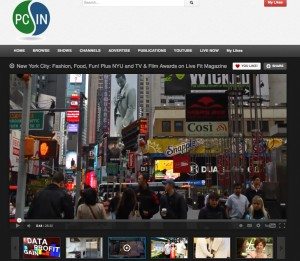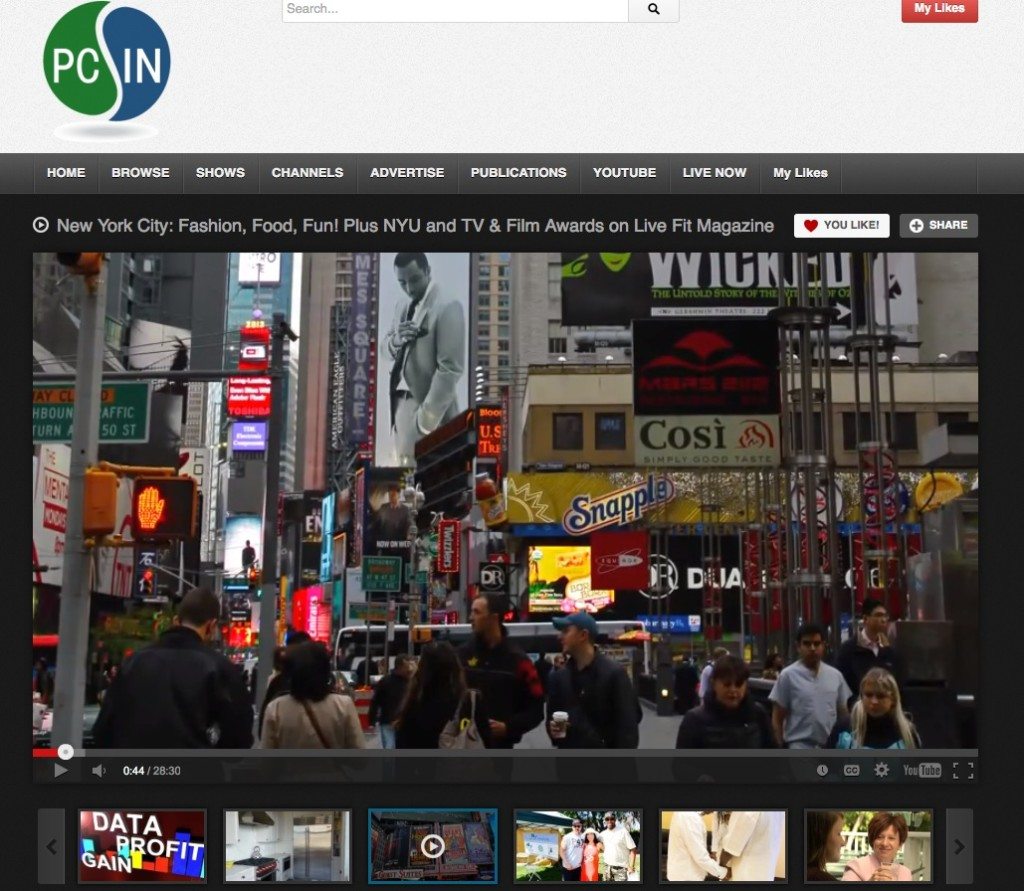 What’s happening to TV? There’s a new star in town… the Internet. All right, it’s not new but TV Networks on the Internet are a fairly new concept that takes some warming up for some, not only to get used to but also to comprehend. See our TV network for an example, PCIN.TV and Live Fit Magazine on YouTube.
What’s happening to TV? There’s a new star in town… the Internet. All right, it’s not new but TV Networks on the Internet are a fairly new concept that takes some warming up for some, not only to get used to but also to comprehend. See our TV network for an example, PCIN.TV and Live Fit Magazine on YouTube.
Today, while more people are beginning to understand how the Internet is the new medium for TV, there are still some trying to comprehend a powerful change that is creating new jobs and industries. Often the conversation goes like this, “Really, I’m going to watch a TV show on my computer?,” they say. “Yes,” I say. And then I add, “Or you might watch it on your flat screen, Internet-ready TV through services like Direct TV or on your iPad or iPhone. Or you might even watch a live broadcast streamed via the Internet and TV Networks on the Web using multiple devices and from anywhere you like.” The point here is the TV world is changing and insiders are scrambling to keep up.
The pros and cons of Internet TV
At one time TV production was for the elite few who had the skill-set, technology, and lucky opportunity to be part of it. Today, nearly anyone can make a video or even a slide show (and call it a video), post it to YouTube and–bam!–it’s on TV. Well, kind of…it’s not being broadcast over the traditional airwaves but the digital world is putting many people on the map. And that’s equalizing the playing field for those who have a story to tell.
Today, multimedia journalists, like myself, can go anywhere in the world with a fairly small bag of gear, shoot a story, and get it to the Internet and also to traditional TV without needing a big, expensive camera or full crew. The story can be produced quickly, efficiently, and effectively.
However, that also means that, as the barrier to entry drops for an industry, the standards of that industry may drop as well. Today, you have people with cameras, who don’t know much about TV, journalism, or even videography, producing videos that make their way to the Internet. That’s not to say that an amateur can’t create a very viral video. It happens all the time. But what we’re talking about here is reliable high-quality TV programming but on the Internet instead of only on television.
Let’s explore the numbers. Since there is a saturation of video content why should anyone pursue this medium? Just think about these mind-blowing statistics from YouTube.
• 100 hours of video are uploaded every minute.
• Over 6 billion hours of video are watched each month.
• More than 1 billion unique users visit YouTube each month.
• According to Nielsen, YouTube reaches more adults ages 18-34 than any cable network.
• Almost 40 percent of YouTube’s global watch time is viewed by people using mobile devices.
In 2009, 600,000 people gave up cable TV and opted for free Internet programming instead. While today some of those digital networks are finding ways to charge their viewers, many people feel better about paying for specific viewing of online programs instead of ongoing monthly cable TV.
“Skate to where the puck is going.” ~Wayne Gretzky. Go to where your viewers already are–the Internet.
You can hold off on building your Website with quality videos or you can be an early adopter and capture the growing audiences on the Web. The integration of TV and Internet TV will collide in a big way in the future. I believe viewers will switch seamlessly from one source to another just as they do today between what used to be “standard TV” and cable.
Social Tv apps will take on a greater presence in the future. These apps will work alongside and in conjunction with what you’re viewing on TV, being able to offer synchronized programming to your smartphone and tablets.
“We have eliminated the walls between TVs and mobile devices to give brands a unified and fluid fan interaction, organically extending their presence everywhere the consumer is,” USA Network’s EVP Alexandra Shapiro said in a prepared statement. [Source: USA Network banks on second-screen devices to boost ad revenue–Fierce Cable.]
Social TV apps such as Beamly and TVTag help viewers connect and use various social platforms to express their views on content. Most people today watch TV and have some sort of other second-screen device that they are simultaneously using. Bringing TV and the Internet closer together is what TV manufacturers are already focused on. It’s predicted that by 2025 everyone will own a smart TV, that’s able to view anything on the Web.
Netflix Chief Product Officer, Neil Hunt, in an article on adage.com, says that TV will be more personalized. Channels will be shaped around an individual, people will pay for what they want to watch streamed through their TV. Advertising will change. Just as Netflix can personalize and make suggestions for its subscribers, based on what they’re viewing, so too, can ads be offered to consumers using the same technology thereby making the ads fewer but much more relevant and targeted to specific consumers.
Having online video content will be one of the main sources of viewer consumption. Having an online video newsroom, podcast, or Google Hangout streaming through your website to your targeted audience will position you as a thought leader and influencer in your industry… just as traditional media is in the mainstream TV environment.
The power is in the storytelling. The influence comes from producing content that offers information, an opportunity to connect and provoke a desire to learn more.
Great online Video News Stories (VNS) consist of five critical components:
1. A compelling story that matters to the audience. Stories that affect more people have greater significance and are often considered more newsworthy by traditional media. The story is built around a Hero and the transformation that occurs. The Hero is not usually the company; rather it’s the person the company is helping.
2. Information that provides help, tips, and added value. The story educates, creates a reason to care, and raises awareness about a problem, concept, event, or person. What makes this story intriguing usually comes from the human interest component of it. These stories typically have an emotional appeal.
3. Sound bites or interviews that don’t use “junk food jargon”. The interviewee must be engaging, truthful, and speaking clearly without using a lot of industry lingo references that will leave the viewer feeling like an outsider. People who are great on camera usually come from a background in TV/film/public speaking or they’ve had professional media coaching to help them succinctly articulate their message in brief statements to a reporter.
4. The newsworthy angle. A two-minute VNS doesn’t give time to include everything. When a reporter covers a story, there are many aspects left out and for good reason. Too many details would confuse the viewer. Find the newsworthy angle and use that to craft a story. If it has a connection to a real-time event, all the better. For instance, if you’re a business in the agriculture industry, producing a story that touches on the issue of a major drought going on in your area and how your company is creatively saving water, can be an excellent tie-in that might also get your story exposure by traditional media. Or here’s another example.
This story showcased an issue that homeowners were having and highlighted how a remodeling company was able to solve their problem.
5. The call to action. Special offers, discounts, where to go for more knowledge, support, or social interaction. It’s a great idea to offer free seminars or Webinars to provide more expert advice. Here’s a video example of how to get the word out to potential guests.
When these Video News Stories are placed on Websites that are surrounded by other engaging information that adds value, visitors stay on your site longer and are many times more likely to pursue your company or product simply because they have the knowledge that they couldn’t gain elsewhere such as in a brief 30-second ad that they see on TV.
This knowledge (via the video and/or written blog post) can be shared easily via the click of a mouse. It’s spreadable and archivable, which makes the content highly useful for consumers. They can bookmark it and return again and again to digest your message.
Want to learn how you can make Video News Stories part of your business messaging? Visit Live Fit Films or call me, I love to brainstorm and help you grow your business.
Note: Follow me for marketing and content resources to grow your company. Join the conversation by commenting below or by visiting AskPhoebe.info.
Listen to The Brand Journalism Advantage Podcast for weekly interviews with thought leaders, marketing & writing tips, and inspiration. Click here to listen.
Join us on an upcoming Webinar to learn the Number One Marketing Strategy!
You’ll learn:
–how to craft brand journalism content
–how to operate like a newsroom, producing content consistently
–to identify and analyze successful case examples of brand journalism
Phoebe Chongchua is a multimedia Brand Journalist who teaches: Think Like A Journalist, To Increase Your Bottom Line. She is also the Host of The Brand Journalism Advantage Podcast which features interviews with thought leaders from around the globe on marketing, brand journalism, and entrepreneurship. After 15 years in TV News as an Anchor/Reporter, Phoebe founded PCIN.TV. The Internet TV Station airs video stories from her online publications: Live Fit Magazine and The Plant-Based Diet as well as curates content from other sources. As a brand storyteller, Phoebe produces business videos, articles, and photos to engage consumers and create brand evangelists. Learn more:TheBrandJournalismAdvantage.com
Contact Phoebe to get started on your Brand Strategy.
